by Sally Kestin, John Boyle and Andrew R. Jones, avlwatchdog.org
In Colorado, occupancy taxes charged on overnight visitor stays pay for first responders, affordable housing and child care for tourism workers.
In California, occupancy taxes fund city and county budgets.
On the Outer Banks, a portion goes to offsetting “the negative impacts of tourism.”
None of that is allowed in Buncombe County.
By law, all of the proceeds from the 6% tax on guests at hotels, vacation rentals, and bed-and-breakfasts goes back to tourism — two-thirds toward visitor promotion and one-third to capital projects that attract tourists. The formula feeds an ever-growing cycle of more visitors, who generate more taxes and more money for the Buncombe County Tourism Development Authority to spend promoting Asheville for more tourists.
The TDA’s $40 million budget is now the largest in North Carolina. Spending on marketing Asheville is more than double that of tourism agencies promoting Raleigh, Charlotte, Greensboro, Winston-Salem, and Wilmington and nearby beaches, Asheville Watchdog found.
“I did not realize that we were so far ahead of everybody else in North Carolina,” said state Sen. Julie Mayfield, D-Buncombe. “All of these other cities do a great job of marketing themselves, and they don’t spend as much money as we do.”
Changing the spending priorities of the Buncombe TDA could be done two ways: The county commission, which levies the occupancy tax, could cut the tax rate, which would effectively reduce the TDA’s budget and the amount available for marketing. State lawmakers also could revise the TDA’s funding structure to shift more of the tax money to local needs.
Mayfield co-sponsored legislation in 2022 that reduced the tourism promotion portion of the TDA’s budget from three-quarters to two-thirds. She said it may be time for a further reduction.
“I think we could get by with spending much less money on marketing,” Mayfield told The Watchdog. “We’re a great city; people know that. We continue to show up at the top of lists in national, regional, international publications. We could absolutely use more of that money to invest back into our community.”
TDA officials have said they need to maintain a robust marketing budget to stay competitive with other destinations that travelers consider, like Charleston, Myrtle Beach and Nashville.
“When we’re looking at the competitive nature of travel and tourism … we are competing for people’s hearts and minds and wallets,” TDA President and CEO Vic Isley said at a recent Leadership Asheville Forum.
Brenda Durden, chair of the TDA and a hotelier, told The Watchdog, “Tourism is part of the DNA of this community.”
The TDA is “a willing and eager investment partner within the guardrails established by our state legislation. Lodging tax is not a cure-all but plays a crucial role in fueling nearly $3 billion in visitor spending to support local businesses.”
(Read the full TDA response to The Watchdog’s request for comment.)
Mayfield said she plans to ask Sen. Warren Daniel, a Republican whose district includes eastern Buncombe, about introducing legislation in 2025 to change the spending formula again, perhaps through a cap on promotion.
Daniel did not respond to requests for comment but proposed the idea in a meeting earlier this year with Mayfield, she said.
Mayfield, a former Asheville City Council member, served as the city’s representative on the TDA board beginning in 2016. “At that time, the marketing budget was something like $9 million, and some of the board members I talked to were saying, ‘Oh my God, we don’t need to spend $9 million marketing Asheville. That’s ridiculous,’” Mayfield said.
This year, the TDA’s budget for tourism promotion is $27.5 million, which includes $19.5 million for marketing. “They just have so much money,” Mayfield said.
She said she also found the “salary disparities at the TDA … pretty shocking.” Isley receives a base salary of $300,000 with total compensation of up to $456,000, while nearly half the staffers at Explore Asheville are paid $45,000 to $65,000.
The explanation is “that’s just what the market demands,” Mayfield said, “but I just think really big salaries like that in a town that is so hard to live in, I think they’re unfortunate.”
Option 2: Buncombe County
Brownie Newman, chair of the Buncombe County Board of Commissioners, said he has “long believed and advocated” for the TDA to spend less on advertising Asheville and “more on addressing community priorities like affordable housing.”
Newman said he suspects many Buncombe residents find the idea of the TDA spending $27.5 million promoting Asheville to potential visitors “pretty crazy,” especially in a community with so many needs, like housing.
“That’s an enormous amount of money that could be used to really address key things that people are concerned about out in the community,” Newman said.
Changing the formula in the law would require agreement from hoteliers and Buncombe elected leaders, and passage by the General Assembly, two potential hurdles.
The County Commission has leverage, not in how the money is spent but in how much the TDA receives. The county levies the occupancy tax.
In 2015, after hoteliers persuaded state lawmakers to allow an increase in the tax to 6% from 4%, the County Commission had to approve it and did so by a 4-3 vote, Newman said.
Newman voted against the increase because of the additional money it would raise for marketing. “We basically said … ‘This is just so out of whack from what the community thinks is the right thing to do.’”
Ultimately, “the county raised the rate,” Newman said. “We could also vote to reduce it back down again.”
Elsewhere, tourists pay for police, child care
Balancing the economic prosperity tourism brings with the impacts and needs of a local community is a struggle taking place across many tourist destinations, especially places like Asheville where visitors contribute to higher housing costs.
Colorado last year passed a law to expand the authorized uses of occupancy taxes to include workforce housing and child care, and local voters decide how the money is spent.
The role of tourism agencies “has evolved to not only support economic growth through tourism, but also to address the social, cultural and environmental issues related to tourism,” the Colorado General Assembly concluded. “A visitor’s experience is also heavily influenced by the host community’s ability to support their residents and local workforce with housing and other essential services. … Robust support for our residents’ needs is essential to the long-term health of both our communities and our economy.”
More than a dozen counties and cities in Colorado have laws directing occupancy tax money outside tourism promotion.
Telluride voters approved spending tax revenue on managing the effects of tourism and for town purposes, including transportation services, improvements to its wastewater treatment facility and affordable housing.
In Dillon, voters approved tax revenue for community projects and services addressing tourism impacts on recreation, public safety, street and parking improvements, and “any other governmental purposes of the town.”
Nederland and Palisade voters directed a portion of the money toward police and emergency services, and in Eagle, to construction and maintenance of trails, restrooms, parking areas and physical improvements to the town’s open space.
Some Colorado towns raised the occupancy tax rate to preserve the tourism marketing budget. Estes Park voters approved a 3.5% increase on top of the existing tax to provide workforce housing and child care.
“If we take away marketing funding, we will lose market share and businesses will close,” said a Q&A on the proposal. “This has been proven over and over in destinations, most notably in the state of Colorado, when they stopped funding tourism marketing in 1993. The state did not regain market share for 20-plus years.”
In California, occupancy tax rates are among the highest in the country. In sparsely populated Sierra County, the 12.5% “bed tax” pays for such general county services as law enforcement, ambulances, parks and promotion of tourism. In San Francisco, revenue from the 14% tax supports arts and cultural causes and the general fund.
In Seattle, just 25% of tax revenue can be used to promote tourism; the rest must be spent equally between affordable housing and the arts.
Even in North Carolina, uses of occupancy taxes vary.
In Charlotte, a portion of the money pays for the NASCAR Hall of Fame and convention centers. In Durham, occupancy taxes help pay for the Durham Performing Arts Center, built in 2008 and considered a premier venue in the Southeast.
In Dare County on the Outer Banks, just 1% of the tax is allocated to the tourism agency; 2% is spent on beach nourishment and 3% goes to the county and six municipalities. That money is used for tourism-related capital projects and “to offset the negative impacts of tourism … for instance, sanitation, water, police, the services needed to support the high number of visitors that we have,” said Lee Nettles, executive director of the Outer Banks Visitors Bureau.
About 3 million people visit Dare County each year, enough to generate sufficient tax revenues for marketing, he said. The budget for the visitors bureau was $9.8 million last year, with $7.5 million for tourism promotion.
“Like you all, we’re a big tourism market,” Nettles said. “So if the number’s big coming in, you can still do what you need to do on the marketing and promotion side, we feel.
“I think it’s very important that the tourism industry try to do everything that it can to have more immediate and tangible good for the people that live in the area,” Nettles said.
Guidelines in N.C. restrict tax use
Of 182 North Carolina counties and cities authorized to collect an occupancy tax, 32 have laws that allow for spending less than two-thirds on tourism promotion, according to an analysis by the Magellan Strategy Group, an Asheville-based consulting firm specializing in tourism and hospitality.
Though occupancy taxes are levied by local governments, they require approval from the N.C. General Assembly through local bills. Buncombe and four other counties were the first in the state to pass an occupancy tax in 1983.
Asheville’s business and elected leaders saw the tax as a way to reverse a declining downtown and boost tourism. Hoteliers supported the idea so long as the money went toward promoting Asheville for travel and tourism.
The 11-person TDA board consists of nine voting members from tourism businesses and two nonvoting representatives from the Asheville City Council and the Buncombe County Board of Commissioners.
By the mid-1990s, other cities and counties in North Carolina had passed occupancy taxes. To ensure uniformity and that “the proceeds were used primarily for tourism,” the state House Finance Committee in 1997 adopted guidelines from the N.C. Travel and Tourism Coalition, a trade association whose members include resorts, attractions and tourism agencies.
Those guidelines state, “at least two-thirds of the proceeds must be used to promote travel and tourism, and the remainder must be used for tourism-related expenditures, which may include beach nourishment.”
Most of the cities and counties in North Carolina that spend less than two-thirds on tourism promotion have laws passed before the guidelines, said Chris Cavanaugh, president of Magellan, the tourism consulting firm.
“There’s actually been very little occupancy tax legislation passed in Raleigh in the last decade,” Cavanaugh said at the Leadership Asheville Forum with Isley, the TDA president.
The state Senate also has guidelines — that are the opposite of the House’s: At least two-thirds must be used for tourism-related expenditures and the rest for tourism promotion.
Those guidelines were created in 2017 when a powerful senator from Onslow County wanted to deviate from the House formula to generate money to build a sports park in his district, Cavanaugh told The Watchdog.
The 2022 bill revising Buncombe’s funding formula “was dead on the floor until a local hotel owner called and had some conversations to educate some folks about how important this was for our community,” Isley said at the Leadership Asheville Forum.
Logjam in Raleigh broken
The House guidelines have been the standard for occupancy tax laws for 26 years but need revision, Mayfield said.
“Tourism in North Carolina has changed,” she said. There’s an “understanding in the tourism industry that destination management organizations need to be investing in their communities in new and different ways and that places that are great for their residents are also great for visitors. And the guidelines that we have don’t reflect that.”
Lawmakers should not stand in the way of cities or counties that come up with a different plan for how to spend occupancy taxes, Mayfield said.
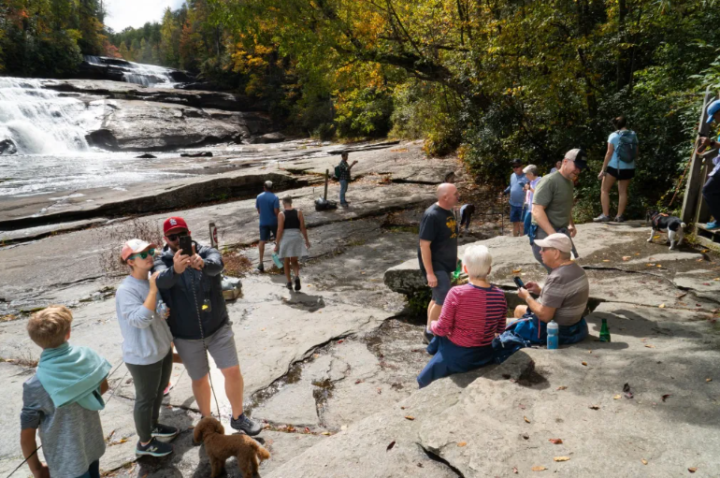
“It’s fine for the legislature to say, ‘This is ideally what we would like things to look like,’” she said. “But if local governments can come to us and explain why they want it to be different, and to me the key thing is, is there unanimity between the TDA, the local governments. … And if that’s there then the legislature should have no business saying no, because the locals know best what they need, what they want, how they want that money to be spent.”
The General Assembly passed a bill the last day of the legislative session in October creating or changing occupancy tax laws for nearly two dozen local governments, all within the two-thirds/one-third House guidelines.
“The dam has broken on occupancy tax legislation,” Mayfield said, “and I don’t anticipate that it will be so difficult to get it through the next time.”
Time for another change, leaders say
Mayfield said she attended a meeting earlier this year with Sen. Daniel, who proposed capping the TDA’s marketing budget. Tax money generated on top of the cap would go into the capital projects portion of the budget or be split instead of two-thirds on promotion and one-third on capital projects, perhaps 50/50, she said.
“It did not go anywhere,” Mayfield said.
Also at the meeting were representatives of the N.C. Restaurant and Lodging Association and the N.C. Travel and Tourism Coalition, “the statewide entities that lobby on this issue and view themselves as the protectors of the occupancy tax,” Mayfield said. They “pushed back very strongly on that and, of course, the TDA did as well.”
She said, “Their argument was, and I didn’t disagree with it, ‘Hey, we just made big changes. Let those play out a little bit.’”
Lynn Minges, president and CEO of the restaurant and lodging association, told The Watchdog the organization opposes any legislation that does not meet the two-thirds/one-third formula in the House guidelines.
If the Buncombe TDA has “too much money,” the tax rate could be lowered, Minges said. “Then try to find funding somewhere else to fund all these other needs, like police and infrastructure and affordable housing. … I don’t think our industry would support changes” like Colorado made.
The 2022 legislation that reduced the TDA’s budget for promotion also changed the one-third designated for tourism-related capital projects. That portion had gone exclusively to a “Tourism Product Development Fund” for projects that “increase patronage of lodging facilities” and promote economic development. More than $80 million has been spent from the fund on at least 45 community projects, including improvements to Pack Square Park, Harrah’s Cherokee Center – Asheville and the riverfronts in Asheville and Woodfin.
Now, half of the one-third goes into a Legacy Investment from Tourism fund for capital projects that “benefit the community at-large” but that also attract overnight visitors.
“I really didn’t want it to be connected to tourism at all,” Mayfield said. “I wanted that fund to be totally focused on investing in the community … so that could open up the use of those dollars for things like affordable housing, transportation … cleaning up downtown, funding police officers, funding more firefighters, funding a downtown ambassador program.
“If we were going to do another shake-up of the legislation, I would want to go back to the language of the LIFT fund and make it more permissive.”
Mayfield said she believes the TDA formula should be reconsidered in 2025. The legislature meets next year but in a short session.
“I would want to try to approach this in a collaborative way, where we’re working with the city and the county and the hoteliers and the TDA and trying to get to a place that we can all agree on,” Mayfield said. “That just takes a long time.”
Mayfield said everyone in Buncombe benefits from tourism, including businesses that depend on visitors and local residents who have far more dining, entertainment and arts options.
“We punch way above our weight in everything: culture, restaurants, beer, music, art, I mean, everything, and we wouldn’t be there if it weren’t for the tourism industry,” she said. “I think there’s still a rebalancing of the money that needs to happen.”
Buncombe County Commissioner Terri Wells, the county’s nonvoting representative on the TDA, said in an email to The Watchdog, “While many people realize that visitors significantly contribute to and support our local businesses, they also are concerned about the quality of life for our residents.
“This is an important conversation for us to have as we work together to build a strong future for our community and ensure it continues to be the place we all want to call home. I would welcome the opportunity to work with our state legislators, county and BCTDA leadership to improve upon the current legislation.”
‘More dramatic’ change needed, advocate says
Ben Williamson, an organizer of Buncombe Decides, an organization advocating for redirecting tourism money to affordable housing for service workers, said that state legislators have already made multiple tweaks to Buncombe’s occupancy tax law. “We need something more dramatic.”
Buncombe rents are among the highest in the state, and wages in many tourism jobs are low.
“Some people are thriving in this tourism economy, but the average worker is still struggling,” Williamson said. “A lot of them are working two or three jobs.”
He said the TDA has “been asked by the state assembly to market this county to tourists, and they have done that extremely well. … We try not to be mad at the TDA.”
Williamson would like to see occupancy tax revenues going “to the county governments or the municipal governments where those taxes were earned, and let those democratically elected officials decide how best to spend them in a transparent budget process where the voters and citizens can participate.
“No one’s calling for tourism to go away,” Williamson said. “Three-fourths of my family are in the service industry. We’re heavily personally invested in the success of tourism in the county.”
Buncombe County Commissioner Parker Sloan said that when he was running for office in 2019, he hadn’t considered the occupancy tax much “other than everyone in Asheville has some sort of opinion about tourists.”
“It really wasn’t until I started talking to the public about how this tax is levied by government but it is not spent by elected officials,” he said. “And I’ve yet to meet a citizen who was not taken aback by that.”
Sloan said it seems the TDA has “had more money than they know what to do with at times.”
He said he supports “a new stand-alone occupancy tax” controlled by the county and cities in Buncombe to use on needs such as affordable housing, early childhood education and higher salaries for teachers and public servants.
The County Commission currently has two options, Sloan said: reduce or eliminate the occupancy tax. “If nothing were to change, this seems like the eventual discussion,” he said.
Some workers in the tourism industry would like to see the county exercise that authority as soon as possible.
In a statement issued Nov. 11, Buncombe Decides and three other groups representing local service workers called on the County Commission to abandon the occupancy tax at its next opportunity in 2024. The groups have collected more than 2,000 signatures on a petition asking the TDA to fund affordable housing.
The statement cited a comment to The Watchdog by Durden, the TDA chair, that “housing is not what TDA is here to do” and said the tourism authority rejected the group’s candidate for a committee that will recommend how to spend millions of dollars in the new LIFT fund.
“Only by boycotting the occupancy tax do we believe that the county can bring the state legislature to the table to renegotiate the terms by which the hotel tax funds are spent,” the statement said. “Eliminating the tax now is, in our view, the only way to force a more democratic, equitable, and just use of this tax in the future.”
Asheville Watchdog is a nonprofit news team producing stories that matter to Asheville and Buncombe County. Sally Kestin is a Pulitzer Prize-winning investigative reporter. Email skestin@avlwatchdog.org. John Boyle has been covering Asheville and surrounding communities since the 20th century. You can reach him at (828) 337-0941, or via email at jboyle@avlwatchdog.org. Andrew R. Jones is a Watchdog investigative reporter. Email arjones@avlwatchdog.org. As a free, nonprofit, volunteer-run news team, The Watchdog’s in-depth coverage of local issues depends on support from the community. Please donate here.


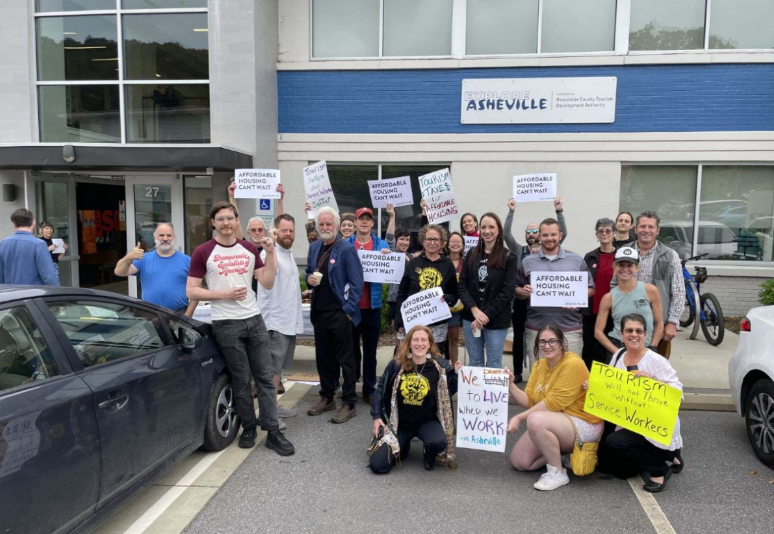

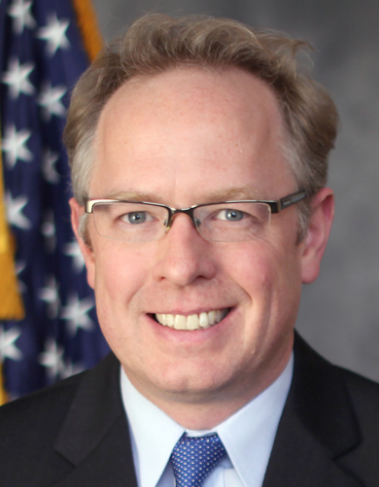
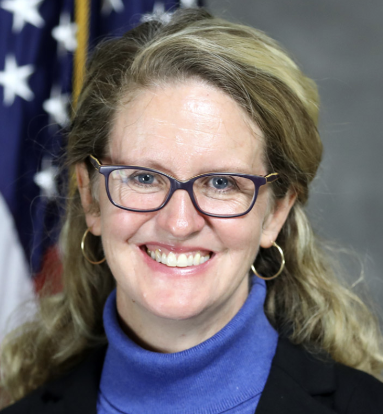
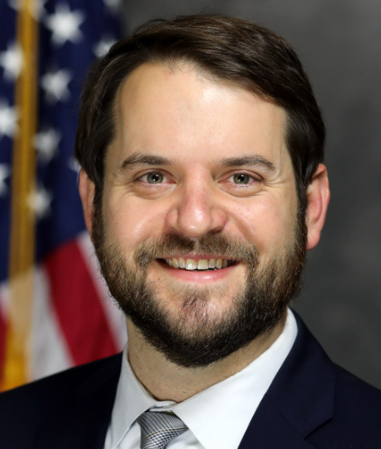
“Sloan said it seems the TDA has “had more money than they know what to do with at times.” Next question…so if TDA has had more money than they know what to do with, where has that money gone? Look at their salaries…embarrassing, disappointing, and disgusting. Res ipsa loquitur.
They (Explore Asheville) make a fortune while the very service workers that provide for tourists can’t even afford to live here. It’s disgusting.
okay, so it seems that the local powers that be… Mayfield/Newman et al… all seem to be in agreement that the TDA is a bit out of control here in Asheville/ Buncombe County ..to put it mildly. And I think we all can also agree that the MAGA controlled state legislature probably isn’t about to change the way this occupancy surcharge tax to promote tourism is apportioned …they’ve never seen a slush fund they didn’t like basically …so I’m a bit skeptical about that despite Julie Mayfield’s optimism regarding its chances of possibly changing. So in the meantime, as Brownie says in this piece.. we need to have the Buncombe County Commissioners again vote on the rate… and get it at least back down to 4%. I’m quite sure Ms. Isley and her very well paid executive staff will fight it tooth and nail ..so the obvious next step is to oust the comfortably ensconced executive crew there at the TDA. Sorry guys, this gravy train has about run out of track… for all the right reasons.
Isley wasn’t recruited here to be the county or city manager, so comparing her compensation package to individuals who made their career choice to work for city and county government isn’t relevant.
But for the sake of argument, simple google searches show that there are executive base salaries for nonprofits in our area at $307K, $555K and $285K. Base salaries for other competitive regional destination execs for Savannah, Myrtle Beach, Nashville, Chattanooga and Charleston are $345K, $378K, $1.1M, $278K and $312K. Watchdog or MountainX couldn’t be bothered to find this easily accessible information themselves? Why was retirement factored in to total compensation for Isley but no other individual? Makes you wonder…
I’m not for or against tourism or Isley, but on the face of it, this doesn’t seem like fair or accurate reporting.
I thought this was supposed to be a progressive town. Appears this place is more about tearing people down than building up.